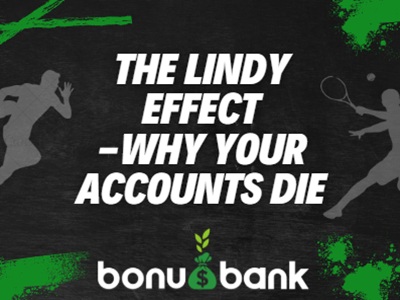When we talk about matched betting, one of the constant challenges is understanding how long our bookmaker accounts will last before being promotion banned (“gubbed”). It’s something every matched bettor experiences, but few attempt to model or predict. Today, we want to look at it through two lesser known ideas, the Lindy Effect and the Doomsday Argument. Both can teach us something about how we should manage our risk, and our bankrolls, over the life of an account. Whilst this doesn’t strictly teach us anything astounding, reading about the principles behind why things are they way they are will make us more informed, and better, matched bettors.
Let’s dive in.
The Lindy Effect: Survival Begets Survival
The Lindy Effect is a theory that says the longer something has survived, the longer it is likely to survive into the future. Originally used to explain the lifespan of ideas, books, or technologies, it can be applied (with caution) to betting accounts too.
In theoretical terms:
- If your betting account has lasted 6 months without a promo ban, it is more likely to last another 6 months.
- If it has survived 12 months, you might expect it to survive another 12.
For matched bettors, this has an important implication, older accounts are more resilient. Bookmakers often monitor new customers heavily in their first weeks or months, but if you survive that early scrutiny, your account becomes more “normal” to them.
Young accounts are fragile. If your account is brand new, you need to be more conservative. Mix mug bets with your value or promo bets, avoid obvious matched betting patterns, and avoid hammering promotions too hard.
As the account ages, you can afford to shift your focus slightly, optimising for higher expected value (EV) even if it means taking slightly more noticeable actions.
The Doomsday Argument: Predicting the End
The Doomsday Argument is another probabilistic concept that estimates how far through a lifespan you might be. If you assume you are randomly positioned somewhere during your account’s total life, you can estimate the remaining time based on how long it has already survived.
Roughly speaking:
- If your account has lasted 3 months, there’s a 50% chance it will last at least another 3 months, and a 50% chance it will die sooner.
- There’s a 95% chance it won’t last more than 60 months (20 times your current life).
This gives you a mental model, every day your account survives without a ban, you should adjust your expectations. Survival for 6 months? Good. But do not become overconfident, the risk of gubbing is always there, hovering in the background.
What This Means for Strategy
Combining these ideas, you could break account life into three broad stages:
| Account Age | Lindy Advice | Doomsday Advice | Practical Tip |
| <2 months | Very fragile | High risk of short lifespan | Be conservative |
| 2-6 months | Gaining durability | 50% chance of doubling lifespan | Mix mug bets and +EV exploitation |
| 6+ months | Growing resilience | Risk still present but lower | Optimise profit, but stay alert |
The key is risk management. Do not behave the same way with a one week old account as you do with a one year old account.
A Side Note on Bankroll and Stake Sizing
There’s another important consideration here, particularly when it comes to no lay matched betting strategies and using promos on horse racing.
Some matched bettors think, “If I lower my stakes, I’ll avoid gubbing because I’m flying under the radar.”
However, this thinking has a serious flaw.
It’s a bit like using a Martingale strategy at a casino, you double your bets after each loss trying to guarantee a win, but eventually, you hit the table limit and bust before making back your losses.
In matched betting, the “table limit” is getting gubbed. If you lower your stakes too much to “fly under the radar,” you risk reaching a gubbing before you have extracted enough EV from the promotions.
Put another way:
- Gubbing is inevitable, it’s not “if,” it’s “when.”
- Therefore, you want to maximise the EV you extract before you get gubbed.
- That means using full promo stakes where possible, not trickling small bets across too many markets.
This requires a bankroll capable of withstanding variance who no laying. If you cannot afford a downswing at full stakes, the answer is not to lower stakes dramatically, the answer is to bankroll properly or use selective promos where variance is lower, like run 2nd/3rds instead of just run 2nds. The advantage of laying bets is that we can weather this variance much easier thanks to all of our bets being hedged, therefore lowering the overall swings of variance we do experience.
By thinking of your account as a limited resource (which it is), you maximise returns before the resource is exhausted.
Final Thoughts
The life of a matched betting account is unpredictable, but not totally mysterious. Concepts like the Lindy Effect and the Doomsday Argument give us useful mental models to approach our betting careers with a better sense of risk and reward.
Your accounts will not last forever, and that’s okay.
What matters is that you extract as much value as possible while they do. Play smart early, optimise later, and always assume the clock is ticking.
The best bettors are not those who never lose an account. They are those who understand that every account has a lifespan, and they plan accordingly.
Want to learn more about efficient no lay strategies and bankroll management? Bonusbank members get access to detailed strategies, tools, and support to help you maximise your returns. Join us today!
Have a question or comment about this article? Join our Discord community to discuss all things matched betting, value betting and EV betting.
